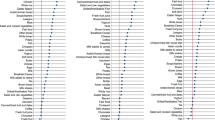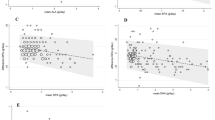Abstract
Background/Objectives:
Comparable international data on food and nutrient intake is often hindered by the lack of a common instrument to assess food intake. The objective of this study was within the Global Allergy and Asthma European Network of Excellence (GA2LEN), we developed and piloted a food frequency questionnaire (FFQ) to assess its validity in Europe.
Subjects/Methods:
Five countries participating in GA2LEN took part in the pilot study. A total of 200 adults aged 31–75 years were invited to complete a FFQ in two occasions and to give a blood sample. The intra-class correlation coefficient (ICC) was used to assess repeatability of the FFQ. Plasma phospholipid fatty acids (FAs) were analysed by gas chromatography. Pearson correlation was used to analyse the correlation between estimated dietary FA intake and plasma phospholipid FA levels.
Results:
A total of 177 participants (89%) had complete data on FFQ1 and plasma phospholipid FAs. In all, 152 participants (76%) completed both FFQs. ICCs between macronutrients ranged from 0.70 (saturated FAs) to 0.78 (proteins) and between 0.70 (retinol) and 0.81 (vitamin D) for micronutrients. Dietary n-3 FAs showed a good correlation with total plasma phospholipid n-3 FAs and with docosahexaenoic acid in the whole sample (0.40) and in individual countries. Poor correlations were observed for other FAs.
Conclusions:
The GA2LEN FFQ is an appropriate tool to estimate dietary intake for a range of nutrients across Europe regardless of cultural and linguistic differences. The FFQ seems to be useful to estimate the intake of n-3 FAs but not other FAs.
This is a preview of subscription content, access via your institution
Access options
Subscribe to this journal
Receive 12 print issues and online access
$259.00 per year
only $21.58 per issue
Buy this article
- Purchase on Springer Link
- Instant access to full article PDF
Prices may be subject to local taxes which are calculated during checkout

Similar content being viewed by others
References
Ashley JM (1996). Lipid biomarkers of adherence to low fat diets. Adv Exp Med Biol 399, 115–129.
Arab L (2003). Biomarkers of fat and fatty acid intake. J Nutr 133, 925S–932S.
Bamia C, Orfanos P, Ferrari P, Overvad K, Hundborg HH, Tjonneland A et al. (2005). Dietary patterns among older Europeans: the EPIC-Elderly study. Br J Nutr 94, 100–113.
Bamia C, Trichopoulos D, Ferrari P, Overvad K, Bjerregaard L, Tjønneland A et al. (2007). Dietary patterns and survival of older Europeans: the EPIC-Elderly Study (European Prospective Investigation into Cancer and Nutrition). Pub Health Nutr 10, 590–598.
Block G, Hartman AM, Naughton D (1990). A reduced dietary questionnaire: development and validation. Epidemiology 1, 58–64.
Brussaard JH, Johansson L, Kearney J (2002). Rationale and methods of the EFCOSUM project. Eur J Clin Nutr 56, S4–S7.
Cade JE, Burley VJ, Warm DL, Thompson RL, Margetts BM (2004). Food-frequency questionnaires: a review of their design, validation and utilisation. Nutr Res Rev 17, 5–22.
Food Standard Agency (2006). Food Portion Sizes Guidelines, 3rd edn, Food Standard Agency: London
Ireland J, van Erp-Baart AM, Charrondiere UR, Moller A, Smithers G, Trichopoulou A et al. (2002). Selection of a food classification system and a food composition database for future food consumption surveys. Eur J Clin Nutr 56, S33–S45.
Hodson L, Skeaff CM, Fielding BA (2008). Fatty acid composition of adipose tissue and blood in humans and its use as a biomarker of dietary intake. Prog Lipid Res 47, 348–380.
Jenab M, Slimani N, Bictash M, Ferrari P, Bingham SA (2009). Biomarkers in nutritional epidemiology: applications, needs and new horizons. Hum Genet 125, 507–525.
Kaaks R, Slimani N, Riboli E (1997). Pilot phase studies on the accuracy of dietary intake measurements in the EPIC project: overall evaluation of results. European Prospective Investigation into Cancer and Nutrition. Int J Epidemiol 26, S26–S36.
Kremmyda LS, Vlachava M, Noakes PS, Diaper ND, Miles EA, Calder PC (2009). Atopy risk in infants and children in relation to early exposure to fish, oily fish, or long-chain omega-3 fatty acids: a systematic review. Clin Rev Allergy Immunol; doi:10.1007/s12016-009-8186-2.
Kuulasmaa K, Tunstall-Pedoe H, Dobson A, Fortmann S, Sans S, Tolonen H (2000). Estimation of contribution of changes in classic risk factors to trends in coronary-event rates across the WHO MONICA Project populations. Lancet 355, 675–687.
Ma J, Folsom AR, Shahar E, Eckfeldt JH (1995). Plasma fatty acid composition as an indicator of habitual dietary fat intake in middle-aged adults. The Atherosclerosis Risk in Communities (ARIC) Study Investigators. Am J Clin Nutr 62, 564–571.
Masala G, Ceroti M, Pala V, Krogh V, Vineis P, Sacerdote C et al. (2007). A dietary pattern rich in olive oil and raw vegetables is associated with lower mortality in Italian elderly subjects. Br J Nutr 98, 406–415.
McCance, Widdowson (2006). The Composition of Foods. 6th edn 2002, Food Standards Agency: (plus updated appendices 2006), The Royal society of Chemistry: UK.
McNaughton SA, Hughes MC, Marks GC (2007). Validation of a FFQ to estimate the intake of PUFA using plasma phospholipid fatty acids and weighed foods records. Br J Nutr 97, 561–568.
Meyer BJ, Mann NJ, Lewis JL, Milligan GC, Sinclair AJ, Howe PR (2003). Dietary intakes and food sources of omega-6 and omega-3 polyunsaturated fatty acids. Lipids 38, 391–398.
Michels KB, Schulze MB (2005). Can dietary patterns help us detect diet-disease associations? Nutr Res Rev 18, 241–248.
Noethlings U, Hoffmann K, Bergmann MM, Boeing H, European Investigation into Cancer and Nutrition (2003). Portion size adds limited information on variance in food intake of participants in the EPIC-Potsdam study. J Nutr 133, 510–515.
Sala-Vila A, Miles EA, Calder PC (2008). Fatty acid composition abnormalities in atopic disease: evidence explored and !QJ;role in the disease process examined. Clin Exp Allergy 38, 1432–1450.
Slimani N, Fahey M, Welch AA, Wirfalt E, Stripp C, Bergstrom E et al. (2002). Diversity of dietary patterns observed in the European Prospective Investigation into Cancer and Nutrition (EPIC) project. Pub Health Nutr 5, 1311–1328.
Subar AF (2004). Developing dietary assessment tools. J Am Diet Assoc 104, 769–770.
Sullivan BL, Williams PG, Meyer BJ (2006). Biomarker validation of a long-chain omega-3 polyunsaturated fatty acid food frequency questionnaire. Lipids 41, 845–850.
Thies F, Nebe-von-Caron G, Powell JR, Yaqoob P, Newsholme EA, Calder PC (2001). Dietary supplementation with eicosapentaenoic acid, but not with other long chain n-3 or n-6 polyunsaturated fatty acids, decreases natural killer cell activity in healthy subjects aged >55 years. Am J Clin Nutr 73, 539–548.
Tjonneland A, Haraldsdóttir J, Overvad K, Stripp C, Ewertz M, Jensen OM (1992). Influence of individually estimated portion size data on the validity of a semi-quantitative food frequency questionnaire. Int J Epidemiol 21, 770–777.
Touvier M, Niravong M, Volatier JL, Lafay L, Lioret S, Clavel-Chapelon F et al. (2009). Dietary patterns associated with vitamin/mineral supplement use and smoking among women of the E3N-EPIC cohort. Eur J Clin Nutr 63, 39–47.
Tunstall-Pedoe H, Vanuzzo D, Hobbs M, Mahonen M, Cepaitis Z, Kuulasmaa K (2000). Estimation of contribution of changes in coronary care to improving survival, event rates, and coronary heart disease mortality across the WHO MONICA Project populations. Lancet 355, 688–700.
Willet W, Stampfer MJ (1986). Total energy intake: implications for epidemiological analyses. Am J Epidemiol 124, 17–27.
Woods RK, Stoney RM, Ireland PD, Bailey MJ, Raven JM, Thien FC et al. (2002). A valid food frequency questionnaire for measuring dietary fish intake. Asia Pac J Clin Nutr 11, 56–61.
Acknowledgements
This GA2LEN study is supported by EU Framework programme for research; contract no. FOOD-CT-2004-506378. We are indebted to the researchers who provided us with the EPIC questionnaires: Dr Kim Overvad, Professor Anne Tjønneland, and Jytte Fogh-Larsen (Denmark); Dr Francoise Clavel-Chapelon and Dr Maryvonne Niravong (France); Professor Antonia Trichopoulou (Greece); Professor Paolo Vineis, Dr Simonetta Salvini, and Dr Domenico Palli (Italy); Åsa Ågren (Sweden); Dr Caroline van Rossum, Dr Jet Smit, Dr Jeanne de Vries, Dr Bas Bueno de Mesquita (The Netherlands); Dr Nick Wareham (UK); Dr Joachim Heinrich (Germany); Dr Eiliv Lund and Guri Skeie (Norway); and to the ECRHS Steering Committee for providing a copy of the ECRHS II FFQ.
Author information
Authors and Affiliations
Consortia
Corresponding author
Ethics declarations
Competing interests
The authors declare no conflict of interest.
Rights and permissions
About this article
Cite this article
Garcia-Larsen, V., Luczynska, M., Kowalski, M. et al. Use of a common food frequency questionnaire (FFQ) to assess dietary patterns and their relation to allergy and asthma in Europe: pilot study of the GA2LEN FFQ. Eur J Clin Nutr 65, 750–756 (2011). https://doi.org/10.1038/ejcn.2011.15
Received:
Revised:
Accepted:
Published:
Issue Date:
DOI: https://doi.org/10.1038/ejcn.2011.15



